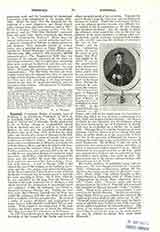

Tunstall, CUTHBERT, Bishop of London, later of Durham, b. at Hackforth, Yorkshire, in 1474; d. at Lambeth Palace, November 18, 1559. He studied both at Oxford and Cambridge, finally graduating LL.D. at Padua. Being an accomplished scholar both in theology and law, as well as in Greek and Hebrew, he soon won the friendship of Archbishop Warham, who on August 25, 1511, made him his chancellor, and shortly after rector of Harrow-on-the-Hill. He became successively a canon of Lincoln (1514) and archdeacon of Chester (1515). He began his diplomatic career as ambassador at Brussels, in conjunction with Sir Thomas More, and there he lodged with Erasmus, becoming the intimate friend of both of them. Further preferments and embassies fell to his lot, till in 1522 he was appointed Bishop of London by papal provision. On May 25, 1523, he became keeper of the privy seal; but neither the work this entailed nor fresh embassies prevented him from making a visitation of his diocese. A visit to Worms (1520-1) had opened his eyes to the dangers of the Lutheran movement and the evils arising from heretical literature. In the divorce question Tunstall acted as one of Queen Katherine’s counsel, but he endeavored to dissuade her from appealing to Rome. On February 21, 1529-30, he was translated by the pope from the Diocese of London to the more important See of Durham, a step which involved the assumption of quasi-regal power and authority within the bishopric (see Diocese of Durham). During the troubled years that followed, Tunstall was far from imitating the constancy of Fisher and More, yet he ever held to Catholic doctrine and practices. He adopted a policy of passive obedience and acquiescence in many matters with which he could have had no sympathy. With regard to the suppression of the monasteries, the king’s ministers so feared his influence that they prevented his attendance at Parliament.
In 1537 Tunstall was given the onerous position of President of the Council of the North, and Scottish affairs occupied much of his attention. Towards the end of Henry’s reign he twice was sent on diplomatic business to France. Under the protectorate of Somerset his religious position became very difficult, but he yielded so far in compliance to the new changes that Gardiner protested. But the lengths to which the reformers went opened his eyes to the real significance of the royal supremacy; a change came over his attitude, and he staunchly maintained the Catholic side, steadily opposing the abolition of chantries, the Act of Uniformity, and the law permitting priests to marry. He seems to have hoped that Warwick might be induced to reverse the anti-Catholic policy of Somerset, but this hope soon failed, and in 1551 he was summoned to London and confined to his house there. During this captivity he composed his treatise, “De Veritate Corporis et Sanguinis Domini nostri Jesu Christi in Eucharistia”, published at Paris in 1554. At the end of 1551 he was removed to the Tower, and a bill for his deprivation was introduced. When this failed, he was tried by a commission (4—October 5, 1552) and deprived of his bishopric. On Mary’s accession he was liberated, and his bishopric, which had been dissolved by Act of Parliament in March, 1553, was reestablished by a further Act in April, 1554. Through Mary’s reign he, being now an octogenarian, ruled his diocese in peace, taking little part either in public affairs or in the persecution of heretics; but on the accession of Elizabeth his firmness in resisting the fresh innovations marked him out for the royal displeasure. He declined to take the oath of supremacy, was summoned to London, and when ordered to consecrate Parker refused to do so. Shortly afterwards he was deprived of his see (September 28, 1559) and committed to Parker’s care as a prisoner at Lambeth Palace, where within a few weeks he died. He thus became one of the eleven confessor-bishops who died prisoners for the Faith.
His works, exclusive of published letters and sermons, are: “De Arte Supputandi Libri IV” (London, 1522); “Confutatio cavillationum quibus SS. Eucharistiae Sacramentum ab impiis Caphernaitis impeti solet” (Paris, 1552); “De veritate Corporis et Sanguinis Domini in Eucharistia Libri II” (Paris, 1554); “Compendium in decem libros ethicorum Aristotelis” (Paris, 1554); “Certaine godly and devout prayers made in Latin by C. Tunstall and translated into Englishe by Thomas Paynelle, Clerke” (London, 1558). Much of his political correspondence is preserved in the British Museum. Despite his weakness under Henry VIII, we may endorse the verdict of the Anglican historian, Pollard, who writes (op. cit. inf.): “Tunstall’s long career of eighty-five years, for thirty-seven of which he was a bishop, is one of the most consistent and honorable in the sixteenth century. The extent of the religious revolution under Edward VI caused him to reverse his views on the royal supremacy and he refused to change them again under Elizabeth.”
EDWIN BURTON

